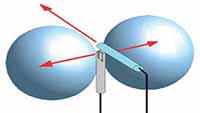 To begin with, let’s sort out what Mid-Side technique is. It was invented by Alan Blumlein in 1933, and apart from the symbol “Mid-Side”, “Middle-Side” and “M-S” stand for it in English and widely used in rap vocals mixing around the globe.
To begin with, let’s sort out what Mid-Side technique is. It was invented by Alan Blumlein in 1933, and apart from the symbol “Mid-Side”, “Middle-Side” and “M-S” stand for it in English and widely used in rap vocals mixing around the globe.
There are a lot of techniques of stereo sound recording with microphones (for more info see articles in the section “microphones and recording”), Mid-Side technique is one of them. Its advantage is perfect mono compatibility on mixing. That is if your stereo recording can be decoded into mono, the sound recorded with the help of Mid microphone will remain in it. That is exactly why this method is often used in sound recording on television. Even if your recording is guaranteed to be played back in stereo (yet it’s practically impossible), with Mid-Side technique you’ll receive stereo which has no problems with decoding into mono.
After recording with the help of such a couple of microphones (cardioid and bidirectional), you can diversify stereo pan on sound mixing by adding new effects and instrument parts. Before recording, place microphones perpendicularly and as closely to each other as possible. After recording the sound, the left channel is formed by the addition of microphone recordings, and the right channel is formed by the subtraction of the channel of a bidirectional microphone from the channel of a cardioid microphone (Mid + Side = Left; Mid – Side = Right). How to implement addition and subtraction?
.jpg) 1. Route the recording from a cardioid microphone to a mixer, pan it dead-centered.
1. Route the recording from a cardioid microphone to a mixer, pan it dead-centered.
2. Route the recording from a bidirectional microphone to the second channel of a mixer, pan it to the left channel.
3. Copy the recording from a bidirectional microphone to the third channel of a mixer, pan it to the right channel. Invert the phase of this channel (if your host program doesn’t miraculously involve channel inversion, you can find a plugin specially intended for it).
Use of Mid-Side recording
So after we have recorded the sound, we decode it into stereo with the help of a mixer. It’s noteworthy that in stem mastering service we can manipulate both stereo and mono recordings simultaneously. Due to it you are given broad options, for instance, you can change the width of a stereo base while sound mixing or process a mono bass drum with an equalizer. All of this is possible if you use Mid-Side plugins. Some plugins allow you to process mono and stereo with a de-esser independently. It gives a fairly good result.
Which plugins support Mid-Side technology?
There are a lot of manufacturers which produce plugins to work with Mid-Side recordings which are widely used at mixing and mastering. As for me, I’d mention the German company Brainworx which now produces quite quality Mid-Side processors. Processor Flux: Alchemist is also fairly good.
Another much better known plugin, which supports Mid-Side, is iZotopes intended for composition mastering. This software work you can hear in available on the website demos of professional mixing mastering services.
.jpg) Each of the windows of this plugin has Mid-Side option which allows the engineer to manipulate mono and stereo signal independently.
Each of the windows of this plugin has Mid-Side option which allows the engineer to manipulate mono and stereo signal independently.
If you need a coder/decoder, the plugin Voxengo “MSED” will suit you.
Mid-Side mastering
The proportion changes of mono and stereo channel levels is the most often used on mixing. As a much more practical example can the work with lead and background vocals be given. The lead vocal is placed into mono, and the background one – into stereo. If the level of the lead vocal sound is too high as compared to background, you can correct it by changing the proportion of sound levels. Plugin Brainworx allows you to set the proportion of sound levels for each frequency range separately. Mid-Side equalization is also quite functional. Unlike standard equalization, mixing engineer can process mono and stereo channels independently.
Another example is the use of high frequency filters which remove low ends from a stereo signal so that you can be sure that all very low frequencies in your composition are placed deadly centered. Mid-Side compression is quite a new occurrence in the sound procession field. Brainworx ‘bx_dynEQ’ is a fairly good instrument in this field. With the help of this plugin you can not only compress separate frequency ranges (a multiband compressor), but also process stereo and mono channels separately what is especially interesting while emphasizing a bass drum part and bass line. The example of this technique you can hear in my mixing mastering examples.
